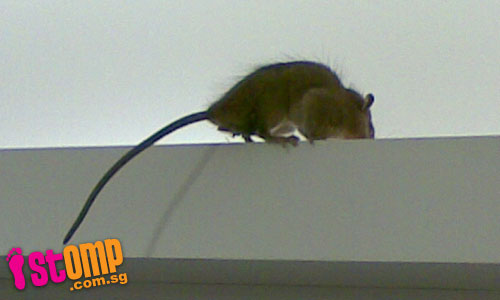
STOMPer Sharon was surprised to see a rat scurrying across the supermarket's dairy section while she was shopping for ice-cream at Cold Storage in North Point yesterday.
When contacted, Sharon said:
"I saw a rat ran across the dairy section counters just as I was about to buy my ice-cream.
"This happened at about 4pm yesterday. There were a few Cold Storage staff looking into the rat problem but they did not stop us from taking any pictures.
"I always shop at Cold Storage for its fresh produce but now, I wonder how clean can this place be?"
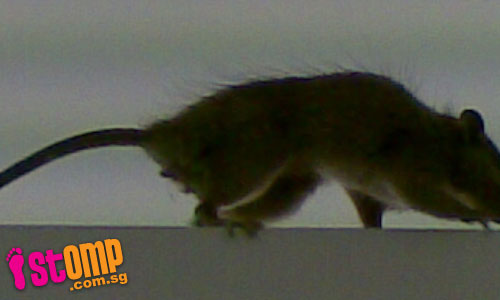


Based on the apparently large size and heavy build of the rat in the photo, I would hazard a guess and say that it is a brown rat (Rattus norvegicus). This is the familiar urban rat seen in cities around the world, and goes by many other names; common rat, sewer rat, and Norwegian rat have all been used at one point or another to refer to this species.

(Photo by andrewsteeleuk)
Supposedly once native to the plains of China and Mongolia, this species has become extremely successful, colonising every continent except for Antarctica. Selective breeding of the brown rat has also given us the laboratory rats that are so vital in research, as well as the fancy rat varieties kept as pets.
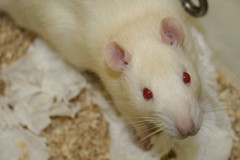

Left: Laboratory rat;
(Photo by jepoirrier)
Right: Fancy rat;
(Photo by P a c i a)
Unlike many other rat species, the brown rat is a poor climber. It is an excellent swimmer, which has helped it to colonise many parts of the world, stowing away on ships and boats and disembarking or swimming for shore whenever an opportunity presented itself.

(Photo by natalija2006)

(Photo by Armando Caldas)
As can be expected, this species is very flexible and adaptable, and readily feeds on whatever food is available, whether it is trash, grain, birds' eggs (or even adult birds), or molluscs. This adaptability has inadvertently created ecological disasters for many species ill-prepared against such an adaptable and intelligent predator.
Predation, competition, and disease spread by the brown rat and other non-native commensal rodents has devastated the fauna and flora of many islands. In recent years, Campbell Island in New Zealand and Rat Island in Alaska have stood out as 2 examples of successful rat eradication efforts to restore threatened native wildlife, especially birds.

(Photo by Armando Caldas)
The story of Christmas Island is particular ironic, in that 2 species of native rat, Maclear's rat (Rattus macleari) and bulldog rat (Rattus nativitatis) became extinct at the turn of the 20th century, not long after the black rat (Rattus rattus) was introduced to the island. It is strongly suspected that the native rats were wiped out by disease spread by the foreign invader.
Apart from the brown rat, there are several other rat species that may be encountered in Singapore. I briefly discussed these species in this post from last year.
Among those other rat species which may be found in urban Singapore are the Asian house rat or Tanezumi rat (Rattus tanezumi) and Polynesian rat (Rattus exulans).
The Asian house rat was once confused with the black rat (Rattus rattus), which has been widely introduced around the world. The Asian house rat itself is possibly native to the Himalayan region, China, and Indochina, but has apparently been introduced to the Malay Peninsula, Indonesia, Philippines, and various island groups in the western Pacific.
Genetic research has indicated that many populations of black rat actually form a separate species, which has been split off and given the name of Asian house rat. Whether or not the black rat itself is found in Singapore remains to be seen, and requires further study; both species do not hybridise readily, even in places where both species are sympatric.
Like the brown rat, the black rat itself also goes by many names; some synonyms include house rat, roof rat, and ship rat. It is considered to be a poor swimmer, but a much better climber compared to the brown rat.

(Photo by Doug Greenberg)
Where both species meet, especially in temperate parts of the world, the larger brown rat is said to be more aggressive, displacing the black rat. Apparently, if both species are occupying the same building, an interesting partitioning of niches occur; the more terrestrial brown rat occupies the sewers and ground floors, while the more arboreal and agile black rat colonises the ceilings and upper floors. In the tropics, however, the black rat is generally more common and more widespread than the brown rat.
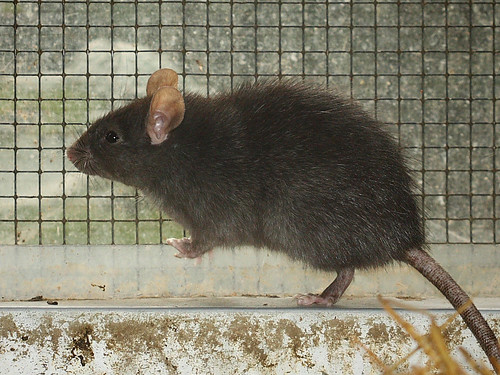
(Photo by Sexecutioner)
Formerly native to the Indian subcontinent, the black rat is also the rat species responsible for the spread of the Black Death across Eurasia during the Middle Ages. Fleas carrying the plague bacterium (Yersinia pestis) after biting infected rats transmitted the disease to humans, resulting in the death of millions of people. Even today, the threat of plague epidemic is still ever present, with the last major outbreak occurring in India in 1994.
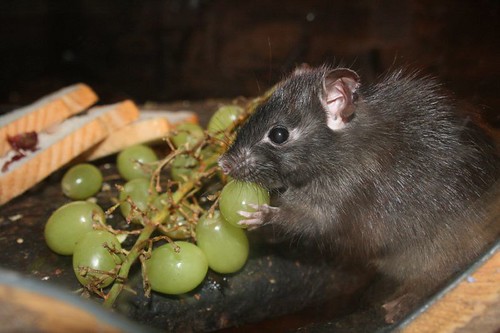
(Photo by nrdsquash)
The Polynesian rat is probably native to mainland Southeast Asia, and has followed Polynesian settlers as they populated far-flung island chains; it is now found throughout the western Pacific, from the Philippines and New Guinea to New Zealand and even as far as Hawaii and Easter Island. Compared to the brown rat and black rat, it is much smaller in size.
There are numerous other commensal rat species found throughout Asia; these include the Indochinese forest rat (Rattus andamanensis), rice-field rat (Rattus argentiventer), lesser rice-field rat (Rattus losea), Himalayan field rat (Rattus nitidus), and Himalayan rat (Rattus pyctoris), not to mention several species of mice (Mus spp.) and the bandicoot rats (Bandicota spp.).
These commensal rodents can be serious pests in agricultural areas, and can pose a significant health risk. Here in urban Singapore, they fulfill a role as scavengers, feeding on our food waste, and in turn are prey for carnivores such as reptiles and birds of prey; research has shown that rats are the main prey of urban reticulated pythons (Broghammerus reticulatus). Like it or not, rodents are part and parcel of urban life, and controlling their numbers is often very much linked to how we manage and dispose of potential food sources.